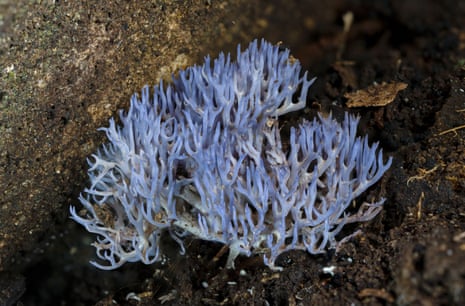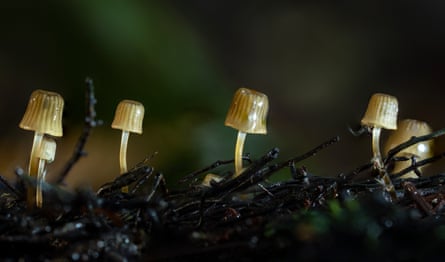One day the forest floor may be filled with leaf litter, soft decomposing logs and tiny tree saplings – the next, the logs flush with gilled oyster mushrooms, rivers of brightly coloured waxgills run along the ground, or puffballs – white orbs, as big as footballs, that suddenly appear in the undergrowth.
Such is the curious world of New Zealand’s fungi, which like the nation’s flora and fauna, have evolved in isolation into more than 20,000 unusual and endemic species. Most fungi are too small to be visible, and of those that you can see, most aren’t mushrooms – they’re lichen, moulds, mildews, rusts and smuts.
They grow in a mix of shapes and sizes, from delicate light green wisps and glistening jellies, to bright orange lattices and gnarled black tongues. The giant puffball can grow over a metre in diameter according to Liv Sisson, author of the recently released field guide, Fungi of Aotearoa. She says they have a habit of appearing out of nowhere.
“I was walking down this path, where days before there was nothing. I turned a corner and there were 20 of them, all the size of my head. It was like these gigantic soccer balls had fallen out of the sky.”
Interest in fungi is growing. Hardware stores in New Zealand are selling growing kits, health stores offer mushroom elixirs and academics are looking into medicinal uses for native hallucinogens. Specialist online interest groups are booming with both members and activity, while one tourist operator beckons visitors with the “spellbinding world of mushrooms”.
“Much like our birds, they really captivate people. They’re so unique and are something to look out for when you’re in the bush anywhere around the country,” says Sisson.
In May, Sisson heard that the visitor centre in Twizel – a town in the South Island known for its landscapes – was fielding more inquiries about fungi than birds. After dwelling in the shadows of ancient towering trees and gawky flightless birds, fungi might be having their time in the spotlight.

“There’s way more fungi lovers out there than I even realised, and there are new people coming to the fold all the time,” says Sisson.
She says that during Covid lockdowns, people took the time to slow down and look closely, and started paying attention to the slippery jacks and eyelash cups.
“It just boomed,” says Kirsty Williams, a member of the Fungigals, a group of four friends who have been “addicted” to fungi for over a decade and can often be found in forests on their hands and knees admiring the specimens.
“You see your first blue Entoloma and you’re hooked,” says Williams.
after newsletter promotion
The Entoloma hochstetteri – or werewere-kōkako in the indigenous Māori language – is a sky blue mushroom with a long slender stipe. They grow on forest floors throughout the country but aren’t commonly seen. So prized is the Entoloma that it appears on the $50 note and in Māori folklore.
Another favourite of the group is the fleshy gloiocephala rubescens, which only grow on rotting nikau palm fronds. Finding a “brain”, as it’s called by the group, elicits cries of glee. There’s also Sarcodon carbonarius, a sooty dark brown species with a spined, or toothed underside.

The strange beauty of fungi is all the more alluring for their transience.
Williams says one day, the fungi is there, “boom, boom, boom … it’s magical. A week later, there’s absolutely nothing. Every time we go out, we see something we haven’t seen before.”
The Fungigals welcome the newfound popularity. Annie Rogers, another member of the group, says, “It’s quite an exciting time to be doing this because it’s becoming mainstream. We meet so many people who are interested in fungi.”

Last month the Fungigals took a group of schoolchildren out spotting. “They got so excited. They all went home and refused to eat mushrooms,” says Rogers.
Yet the growing popularity comes with concern and the group caution spotters to be mindful of protecting the species and their habitat.
“We don’t go in and move things or pick things. We go with a sense of reverence to being out there and how amazing everything is. We are visitors, just looking, and we don’t want to leave anything more than our footprints.” says Rogers.

